The $221 Billion Volunteer Bubble
When Ben Franklin organized the Union Fire Company in 1736, the organization had a simple mission, “ members of the fire company pledged to help one another should fire break out or threaten one of their homes or businesses.” The Union Fire Company became the nation’s fire volunteer fire department.
The need for volunteer fire protection grew organically through the unintentional creation of a dense Philadelphia cityscape lacking building codes. Making matters worse, the city of Philadelphia owned just a single horse drawn steam pumper. A small cooking fire could quickly turn into a multi-block inferno without quick action. It was in everyone’s best interest to volunteer their time to the communal cause and each member “provided at least two buckets for carrying water and several cloth bags for carrying items rescued from the fire”.
Volunteer fire companies started to form across mid-Atlantic cities and many of our most notable founding fathers organized and participated as volunteer firemen — including “George Washington, Thomas Jefferson, Benjamin Franklin, Samuel Adams, John Hancock, Paul Revere, Alexander Hamilton, John Jay, John Barry, Aaron Burr, Benedict Arnold, James Buchanan and Millard Fillmore”.
In each case, these volunteer organizations were created by a need for their services and the willingness of the members to provide that service at no cost.
Growth of Municipal (paid/career) Fire Departments
Urban growth across the country outpaced the capabilities of volunteer bucket brigades in major cities. Fatal fires across the country resulted in hundreds of civilian deaths, leading to the development and expansion of career fire departments with full-time 24/7 paid staff. Following the 1906 earthquake, 25,000 buildings burned in the Great San Francisco Fire, setting the stage for the expansion of the ranks of career personnel in the San Francisco Fire Department.
Around the same time period, the infamous 1911 Triangle Shirtwaist blaze in New York City killed 146 factory workers and injured hundreds of others, leading to the creation of municipal fire codes and expansion of the Fire Department of New York City.
In the post-WWII boom of suburban sprawl in the 1950’s and 60’s, the emergency call load for volunteer fire departments quickly outpaced their ability to respond. Volunteers who also worked 9–5 at other jobs were unable to meet the daytime demands for fire department service, which expanded to include emergency medical services and vehicle accident rescues. As a result, many suburban departments began hiring paid day workers.
In the 1970’s, the bombshell report America Burning from the The National Commission on Fire Prevention and Control highlighted the United States as having the highest number of fire-related deaths of any industrialized country. This spurred local government’s investments in suburban areas to transform individual volunteer companies into county-level fire services staffed by full-time employees.
Reliance on Volunteer Firefighters
While big city career fire departments grew, suburban and rural fire protection continued to depend exclusively on volunteers. Many stations were equipped with a siren mounted on the roof of the station and volunteers would “come in on the whistle” then follow the smoke to the scene of the fire.
Many volunteers were outfitted with whatever equipment was available and most training was informal. Even without extensive training, these volunteers were the only resource available in rural communities that could not afford any type of tax-funded municipal fire protection.
Today, much of the country still relies on volunteers. According to the NFPA, “ most of the career firefighters (71%) work in communities that protect 25,000 or more people. Most of the volunteer firefighters (95%) are in departments that protected fewer than 25,000 people. There are an estimated 29,727 fire departments in the United States. Of these, 2,651 departments were all career, 1,893 were mostly career, 5,421 were mostly volunteer and 19,762 were all volunteer.”
51% of Americans — 164.8 million citizens — are reliant on exclusively volunteer fire departments for emergency 9–1–1 services.
The Volunteer Bubble
From the 1950's-mid 80’s, 80% of firefighters were volunteers. That number has dropped every year since then.
An average career firefighter costs about $100k per year in salary, benefits, and pension. There are currently 346,150 (31%) career and 788,250 (69%) volunteer across the country in the NFPA 2016 survey.
If the downward volunteer trend continues and becomes a 50%-50% split by 2030, local governments will need to find a cumulative $221 billion per year just to cover the new career firefighter salaries! This amount of money is an unrealistic cost for local jurisdictions and taxpayers to cover.
The New York Times story The Disappearing Volunteer chronicles how “the ranks of volunteers are dwindling. What was once an iconic part of American life is losing its allure”. Regardless of the reason, there is a quarter TRILLION dollar bubble nearing the point of bursting and when it does, governments at every level are not prepared to deal with the consequences of a dramatic shift from a majority of free volunteers to compensated municipal fire protection services.
The founding fathers created the first volunteer fire departments because of their engagement and personal investment in civil service. Individuals from the current and next generations must answer this same call to action or else our local communities across the nation will face crippling new budget requirements that we are collectively incapable of covering.
David Riedman is an expert in critical infrastructure protection, disaster preparedness, and emergency management. He is a co-founder of the Center for Homeland Defense and Security’s Advanced Thinking and Experimentation (HSx) Program at the Naval Postgraduate School.
